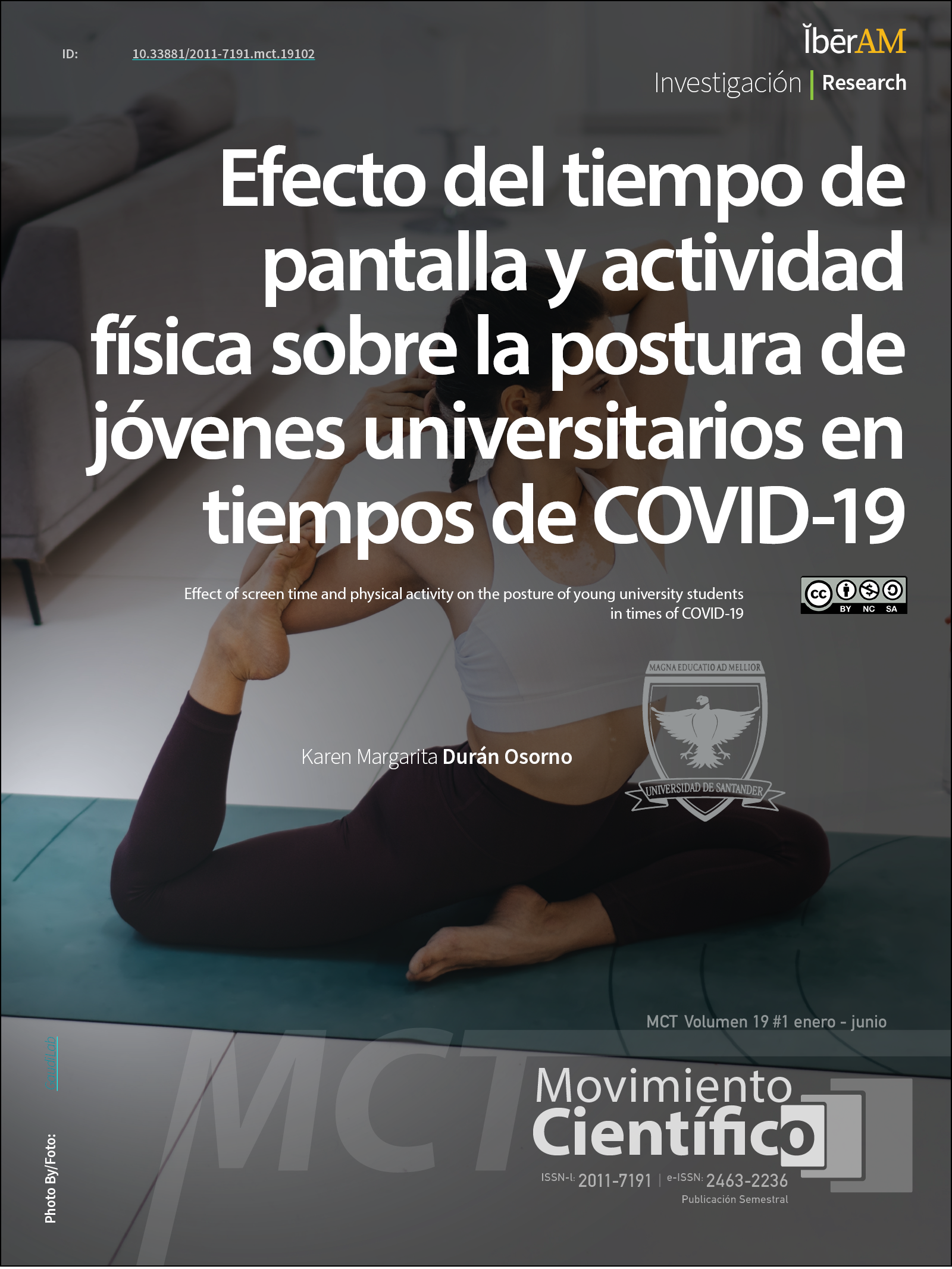The effect of screen time and physical activity on the posture of young university students during the COVID-19 pandemic.
Efecto del tiempo de pantalla y actividad física sobre la postura de jóvenes universitarios en tiempos de COVID-19
Main Article Content
Introduction: It is estimated that a significant proportion of young university students between 17 and 22 years old present some postural alteration, as well as sedentary behaviors related to the use of screens, which has led to increasingly lower levels of physical activity in this population, especially in the early stages of COVID-19. The objective of this research was to analyze the effect that screen time and level of physical activity have on body posture in university students in preventive isolation due to COVID-19. Materials and Methods: Quantitative study, with an observational, analytical cross-sectional design, in which 67 university students between 18 and 23 years old participated. They were evaluated using the Television and Video Measures (TVM) questionnaires, the Global Physical Activity Questionnaire (GPAQ), and posturography through the SAPO software version Beta 0.69. Results: 98.51% of the students had a low level of physical activity, the most used screens were the smartphone (35.85±18.96 hrs) and the computer (24.84±18.20 hrs); A weak correlation was found between the use of the smartphone and the computer with the longitudinal alignment of the lower limbs, no significant differences were found in the postural alignment with respect to practicing or not some type of physical activity, but there were in the daily and weekly use of the television. Conclusion: Screen time and the practice or not of physical activity generate a significant effect on the alignment of tibial tuberosities and the leg-hindfoot angle in the sample studied.
Downloads
Publication Facts
Reviewer profiles N/A
Author statements
Indexed in
-
—
- Academic society
- N/A
- Publisher
- Bogotá: Corporación Universitaria Iberoamericana
Article Details
Abdel-Aziem, A. A., Abdel-Ghafar, M. A. F., Ali, O. I., & Abdelraouf, O. R. (2022). Effects of smartphone screen viewing duration and body position on head and neck posture in elementary school children. Journal of Back and Musculoskeletal Rehabilitation, 35(1), 185–193. https://doi.org/10.3233/BMR-200334/ASSET/IMAGES/LARGE/10.3233_BMR-200334-FIG1.JPEG DOI: https://doi.org/10.3233/BMR-200334
Álvarez Cadena, K. A., Mora Alvarado, K. G., Pilamunga Asacata, D. E., & Naranjo Kean Chong, M. K. (2020). Tiempo en pantalla (televisión, computadora, celular, tabletas) en las relaciones interpersonales entre niños de 8 a 12 años. Revista de Investigación En Ciencias de La Educación, 4(15), 258–266. DOI: https://doi.org/10.33996/revistahorizontes.v4i15.113
Arango-Vélez, E. F., Echavarría-Rodríguez, A. M., Aguilar-González, F. A., & Patiño-Villada, F. A. (2020). Validation of two questionnaires to assess the level of physical activity and sedentary time in a Colombian university community. Revista Facultad Nacional de Salud Publica, 38(1). https://doi.org/10.17533/udea.rfnsp.v38n1e334156 DOI: https://doi.org/10.17533/udea.rfnsp.v38n1e334156
Braz, R. G., Goes, F. P. D. C., & Carvalho, G. A. (2017). CONFIABILIDADE E VALIDADE DE MEDIDAS ANGULARES POR MEIO DO SOFTWARE PARA AVALIAÇÃO POSTURAL. Fisioterapia Em Movimento (Physical Therapy in Movement), 21(3). https://periodicos.pucpr.br/fisio/article/view/19185
Bringué, X., & Sádaba, C. (2008). LA GENERACIÓN INTERACTIVA EN IBEROAMÉRICA Niños y adolescentes ante las pantallas. In Colección Fundación Telefónica, Ariel. Barcelona. https://hdl.handle.net/10171/7307
Buñay-Yasaca, L. A., Chiriboga-Larrea, G. A., Vega-Falcón, V., & Lana-Cisneros, J. E. (2022). Estimación de trastornos musculoesqueléticos por uso de pantallas en trabajadores de una empresa aseguradora. Revista Arbitrada Interdisciplinaria de Ciencias de La Salud. Salud y Vida, 6(2), 268–275. https://doi.org/10.35381/s.v.v6i2.2093 DOI: https://doi.org/10.35381/s.v.v6i2.2093
Castro, L., Gómez, V., & Landívar, R. (2018). Prevalencia de alteraciones posturales de la columna vertebral, asociada al carente hábito deportivo, en jóvenes de 17 a 22 años de edad abril-junio del 2017. Revista Medica La Paz, 24(2), 18–23.
Chastin, S. F., Mandrichenko, O., & Skelton, D. A. (2014). The frequency of osteogenic activities and the pattern of intermittence between periods of physical activity and sedentary behaviour affects bone mineral content: The cross-sectional NHANES study. BMC Public Health, 14(1). https://doi.org/10.1186/1471-2458-14-4 DOI: https://doi.org/10.1186/1471-2458-14-4
Devi, K. A., & Singh, S. K. (2023). The hazards of excessive screen time: Impacts on physical health, mental health, and overall well‑being. Journal of Education and Health Promotion, 12(1). https://doi.org/10.4103/JEHP.JEHP_447_23 DOI: https://doi.org/10.4103/jehp.jehp_447_23
Ferreira, E. A. G., Duarte, M., Maldonado, E. P., Burke, T. N., & Marques, A. P. (2010). Postural Assessment Software (PAS/SAPO): Validation and Reliabiliy. Clinics, 65(7), 675–681. https://doi.org/10.1590/S1807-59322010000700005 DOI: https://doi.org/10.1590/S1807-59322010000700005
Forero, G. A., Sala, X. B., & Chalezquer, C. S. (2010). La generación interactiva en Colombia: adolescentes frente a la Internet, el celular y los videojuegos. Anagramas Rumbos Sentidos Comun. https://revistas.udem.edu.co/index.php/anagramas/article/view/464/417
González-Menéndez, E., López-González, J., González Menéndez, S., García González, G., & Álvarez Bayona, T. (2019). COLABORACIÓN ESPECIAL PRINCIPALES CONSECUENCIAS PARA LA SALUD DERIVADAS DEL USO CONTINUADO DE NUEVOS DISPOSITIVOS ELECTRÓNICOS CON PVD. Rev Esp Salud Pública, 93, 30–31. www.msc.es/resp
Hodelín, Y. H., Luz De Los, Z., García, R., Cumbá, G. H., & Salmon, M. B. (2016). Riesgos sobre tiempo prolongado frente a un ordenador. Revista Información Científica, ISSN-e 1028-9933, Vol. 95, No. 1, 2016, Págs. 175-190, 95(1), 175–190. https://dialnet.unirioja.es/servlet/articulo?codigo=6027406&info=resumen&idioma=ENG
Hurtado, A. F. V., Ramos, O. A., Jácome, S. J., & Cabrera, M. del M. M. (2020). Actividad física y ejercicio en tiempos de COVID-19. CES Medicina, 34, 51–58. https://doi.org/10.21615/CESMEDICINA.34.COVID-19.6 DOI: https://doi.org/10.21615/cesmedicina.34.COVID-19.6
INSST. (2020). Riesgos ergonómicos en el uso de las nuevas tecnologías con pantallas de visualización. Nota Técnica de Prevención 1150, 1–5. https://www.insst.es/documents/94886/566858/NTP+1150+Riesgos+ergonómicos+en+el+uso+de+las+nuevas+tecnologías+con+pantallas+de+visualización+-+Año+2020.pdf/0ce76d93-5654-ae2f-2951-1918026c5133?version=2.0&t=1614878622461
Koedijk, J. B., van Rijswijk, J., Oranje, W. A., van den Bergh, J. P., Bours, S. P., Savelberg, H. H., & Schaper, N. C. (2017). Sedentary behaviour and bone health in children, adolescents and young adults: a systematic review–supplementary presentation. Osteoporosis International, 28(10), 3075–3076. https://doi.org/10.1007/s00198-017-4195-9 DOI: https://doi.org/10.1007/s00198-017-4195-9
Martí Trujillo, S. (2011). Actividad física, sedentarismo frente a pantallas y su relación en adolescentes [Universidad de Las Palmas de Gran Canaria]. https://accedacris.ulpgc.es/bitstream/10553/9810/4/0665819_00000_0000.pdf
Nanjarí-Miranda, R., Aranda-Bustamante, F., Saavedra-León, V., Zuñiga-Vivanco, J., Castillo-Paredes, A., Yáñez-Sepúlveda, R., & Olivares-Arancibia, J. (2024). Higiene postural: factores que influyen en una correcta postura en niños y adolescentes. Una revisión sistemática (Postural hygiene: factors that influence correct posture in children and adolescents. A systematic re-view). Retos, 56, 374–384. https://doi.org/10.47197/RETOS.V56.96405 DOI: https://doi.org/10.47197/retos.v56.96405
Navarrete, H. P. (2023). Relación entre tiempo frente a pantalla y actividad física en adolescentes. REVISTA CHILENA DE REHABILITACIÓN Y ACTIVIDAD FÍSICA. https://revistas.uautonoma.cl/index.php/reaf/article/view/2081/1423 DOI: https://doi.org/10.32457/reaf2.2081
Nguyen, P., Le, L. K. D., Nguyen, D., Gao, L., Dunstan, D. W., & Moodie, M. (2020). The effectiveness of sedentary behaviour interventions on sitting time and screen time in children and adults: An umbrella review of systematic reviews. International Journal of Behavioral Nutrition and Physical Activity, 17(1), 1–11. https://doi.org/10.1186/S12966-020-01009-3/TABLES/2 DOI: https://doi.org/10.1186/s12966-020-01009-3
Rivera, P. A., Nys, B. L., & Fiestas, F. (2021). Impact of COVID-19 induced lockdown on physical activity and sedentary behavior among university students: A systematic review. Medwave, 21(8). https://doi.org/10.5867/MEDWAVE.2021.08.8456 DOI: https://doi.org/10.5867/medwave.2021.08.8456
Rodríguez-Cáceres, A., Alejandra Sánchez-Vera, M., Alfonso-Mora, M., Sarmiento-Gonzalez, P., Lever Méndez, J., Milena, A., Becerra, G., Guerra-Balic, M., & Sánchez-Martin, R. (2023). Relación entre la exposición a pantallas, el comportamiento sedentario y el dolor musculoesquelético en adolescentes: revisión sistemática. Retos: Nuevas Tendencias En Educación Física, Deporte y Recreación, ISSN-e 1988-2041, ISSN 1579-1726, No. 50, 2023, Págs. 1064-1070, 50(50), 1064–1070. https://dialnet.unirioja.es/servlet/articulo?codigo=9080274&info=resumen&idioma=ENG DOI: https://doi.org/10.47197/retos.v50.99865
Rubio-Tomás, T., Skouroliakou, M., & Ntountaniotis, D. (2022). Lockdown Due to COVID-19 and Its Consequences on Diet, Physical Activity, Lifestyle, and Other Aspects of Daily Life Worldwide: A Narrative Review. International Journal of Environmental Research and Public Health, 19(11), 6832. https://doi.org/10.3390/IJERPH19116832 DOI: https://doi.org/10.3390/ijerph19116832
Sadarangani, K. P., De Roia, G. F., Lobo, P., Chavez, R., Meyer, J., Cristi-Montero, C., Martinez-Gomez, D., Ferrari, G., Schuch, F. B., Gil-Salmerón, A., Solmi, M., Veronese, N., Alzahrani, H., Grabovac, I., Caperchione, C. M., Tully, M. A., & Smith, L. (2021). Changes in sitting time, screen exposure and physical activity during covid-19 lockdown in south american adults: A cross-sectional study. International Journal of Environmental Research and Public Health, 18(10). https://doi.org/10.3390/ijerph18105239 DOI: https://doi.org/10.3390/ijerph18105239
Sadarangani, K. P., Schuch, F. B., De Roia, G., Martínez-Gomez, D., Chávez, R., Lobo, P., Cristi-Montero, C., Werneck, A. O., Alzahrani, H., Ferrari, G., Ibanez, A., Silva, D. R., Von Oetinger, A., Matias, T. S., Grabovac, I., & Meyer, J. (2023). Exchanging screen for non-screen sitting time or physical activity might attenuate depression and anxiety: A cross-sectional isotemporal analysis during early pandemics in South America. Journal of Science and Medicine in Sport, 26(6), 309–315. https://doi.org/10.1016/j.jsams.2023.04.007 DOI: https://doi.org/10.1016/j.jsams.2023.04.007
Saunders, T., & Colley, R. C. (2024). Regional trends in the moderate-to-vigorous intensity physical activity and screen time of Canadians before and during the COVID-19 pandemic. PeerJ, 12, 1–27. https://doi.org/10.7717/peerj.16913 DOI: https://doi.org/10.7717/peerj.16913
Sengsoon, P., & Siriworakunsak, K. (2023). A comparison of muscle activity, posture and body discomfort during the use of different computer screen sizes. International Journal of Occupational Safety and Ergonomics : JOSE, 29(1), 424–430. https://doi.org/10.1080/10803548.2022.2054543 DOI: https://doi.org/10.1080/10803548.2022.2054543
Tandon, P. S., Zhou, C., Johnson, A. M., Gonzalez, E. S., & Kroshus, E. (2021). Association of Children’s Physical Activity and Screen Time With Mental Health During the COVID-19 Pandemic. JAMA Network Open, 4(10), e2127892. https://doi.org/10.1001/JAMANETWORKOPEN.2021.27892 DOI: https://doi.org/10.1001/jamanetworkopen.2021.27892
Werneck, A. O., Vancampfort, D., Oyeyemi, A. L., Stubbs, B., & Silva, D. R. (2018). Associations between TV viewing, sitting time, physical activity and insomnia among 100,839 Brazilian adolescents. Psychiatry Research, 269, 700–706. https://doi.org/10.1016/J.PSYCHRES.2018.08.101 DOI: https://doi.org/10.1016/j.psychres.2018.08.101
Wunsch, K., Kienberger, K., & Niessner, C. (2022). Changes in Physical Activity Patterns Due to the COVID-19 Pandemic: A Systematic Review and Meta-Analysis. International Journal of Environmental Research and Public Health, 19(4), 2250. https://doi.org/10.3390/IJERPH19042250/S1 DOI: https://doi.org/10.3390/ijerph19042250
Yaşarer, Ö., Mete, E., Kaygusuz Benli, R., Kılıç, B. B., Doğan, H., & Sarı, Z. (2024). Association between smartphone addiction and myofascial trigger points. BMC Musculoskeletal Disorders, 25(1), 1–9. https://doi.org/10.1186/S12891-024-07383-4/TABLES/2 DOI: https://doi.org/10.1186/s12891-024-07383-4
Zamarripa, J., Marroquín-Zepeda, S. D., Ceballos-Gurrola, O., Flores-Allende, G., & García-Gallegos, J. B. (2021). Nivel de actividad física y conductas sedentarias antes y durante el confinamiento a causa del COVID-19 en adultos mexicanos (Level of physical activity and sedentary behaviors before and during confinement due to COVID-19 in Mexican adults). Retos, 42, 898–905. https://doi.org/10.47197/RETOS.V42I0.87278 DOI: https://doi.org/10.47197/retos.v42i0.87278














